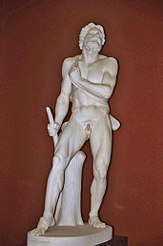Herman Wilhelm Bissen
- Machine translation, like DeepL or Google Translate, is a useful starting point for translations, but translators must revise errors as necessary and confirm that the translation is accurate, rather than simply copy-pasting machine-translated text into the English Wikipedia.
- Do not translate text that appears unreliable or low-quality. If possible, verify the text with references provided in the foreign-language article.
- You must provide copyright attribution in the edit summary accompanying your translation by providing an interlanguage link to the source of your translation. A model attribution edit summary is
Content in this edit is translated from the existing Danish Wikipedia article at [[:da:Herman Wilhelm Bissen]]; see its history for attribution. - You may also add the template
{{Translated|da|Herman Wilhelm Bissen}}to the talk page. - For more guidance, see Wikipedia:Translation.
Herman Wilhelm Bissen | |
|---|---|
 | |
| Born | (1798-10-13)13 October 1798 Schleswig, Duchy of Schleswig |
| Died | 10 March 1868(1868-03-10) (aged 69) Copenhagen, Denmark |
| Nationality | Danish |
| Education | Royal Danish Academy of Fine Arts |
| Known for | Sculpting |
| Notable work | Isted Lion (Istedløven) |
| Movement | Danish Golden Age, Neoclassicism |
| Awards | Order of the Dannebrog |
Herman Wilhelm Bissen (13 October 1798 – 10 March 1868) was a Danish sculptor.[1] Bissen created a number of public works, working in plaster, marble and bronze.
The National Gallery of Denmark owns a collection of over two hundred of his works, including over one hundred busts. Among his notable works are the monumental Landsoldaten (1858) in Fredericia, the statue of Adam Oehlenschläger (1854–61) in front of the Royal Danish Theatre in Copenhagen, and the equestrian statue of King Frederik VII of Denmark in front of Christiansborg Castle.[2]
Biography
Bissen studied at the Royal Danish Academy of Fine Arts in Copenhagen from 1816 to 1823. In 1824, he was awarded a travel scholarship which enabled him to travel to Rome. The stay in Rome extended over 10 years during which time he became an assistant to Danish sculptor Bertel Thorvaldsen. Under the influence of Thorvaldsen, his style changed from romanticism to neo-classicism.
In early 1834, Bissen left Rome to return to Copenhagen where he was awarded a professorship at the Royal Danish Academy of Fine Arts following the death of his predecessor, Hermann Ernst Freund. From 1850 to 1853, he was director of the academy.[3] Several of his works were exhibited at the Great Exhibition of 1851 including his statue of Orestes.
His monument from 1862, Isted Lion (Istedløven), was erected in recognition of Danish victory during the Battle of Isted which was fought as part of the First Schleswig War. The statue was originally erected at Flensburg in Schleswig. In 1867, it was moved to Berlin and remained there until 1945. After World War II, it was located to Søren Kierkegaards Plads in Copenhagen. In September 2011 it returned to Flensburg.[4]
Personal life
Bissen was born at Schleswig in the Duchy of Schleswig. He was the son of Christian Gottlieb Wilhelm Bissen (1766–1847), a farmer, and Anna Margrethe Dorothea Elfendal (1763–1848).
Bissen was married twice. In 1836, he married Emilie Hedvig Møller. She died in 1850 and two years later, and he remarried to Marie Cathrine Sonne. He was the father of sculptor Vilhelm Bissen and landscape painter Rudolf Bissen [da]. Bissen died of pneumonia in 1868. His funeral took place at the Vor Frue Kirke in Copenhagen and was followed by his burial at Assistens Cemetery.[5][6]
Works
-
 Vulcan (1838)
Vulcan (1838) -
 The Wrathful Achilles (1864-66)
The Wrathful Achilles (1864-66) -
 The Wounded Philoctetes (1854-1855)
The Wounded Philoctetes (1854-1855) -

- Hylas (1846)
- Girl Setting her Hair (1842)
References
- ^ "H.W. Bissen". Ministry of Culture (in Danish). Kunstindeks Danmark. Archived from the original on 16 May 2018. Retrieved 1 May 2018.
- ^ "Herman Wilhelm Bissen" (in Danish). Kulturcentret Assistens. Archived from the original on August 13, 2016. Retrieved 1 May 2018.
- ^ "Herman Vilhelm Bissen" (in Danish). Den Store Danske. Retrieved 1 May 2018.
- ^ "Istedløven" (in Danish). Den Store Danske. Retrieved 1 May 2018.
- ^ "Vilhelm Bissen" (in Danish). Den Store Danske. Retrieved 1 May 2018.
- ^ "Rudolf Bissen" (in Danish). Kunstindeks Danmark. Retrieved 1 May 2018.
External links
- Photo gallery of works by of Bissen
- Biography of Bissen
 Media related to Herman Wilhelm Bissen at Wikimedia Commons
Media related to Herman Wilhelm Bissen at Wikimedia Commons
| Cultural offices | ||
|---|---|---|
| Preceded by | Director of the Royal Danish Academy of Fine Arts 1850–1853 | Succeeded by |
- v
- t
- e
- Statue of Anders Sandøe Ørsted (1837)
- Statue of Frederick VI (1858)
- Isted Lion (1862)
- Equestrian statue of Frederick VII (1873)
- Vilhelm Bissen (father)
- Carl Edvard Sonne (brother-in-law)
- Jørgen Sonne (brother-in-æaw)















